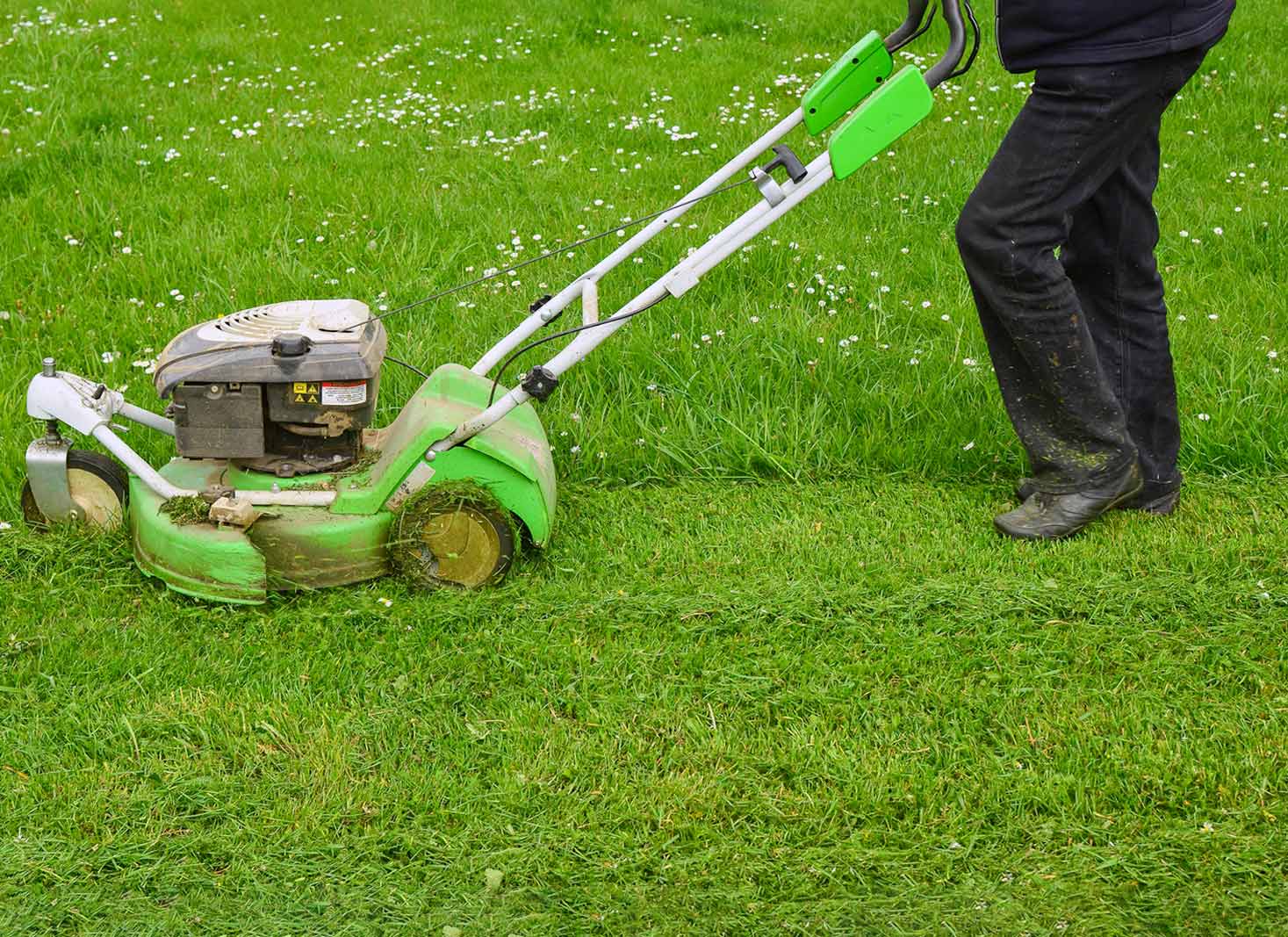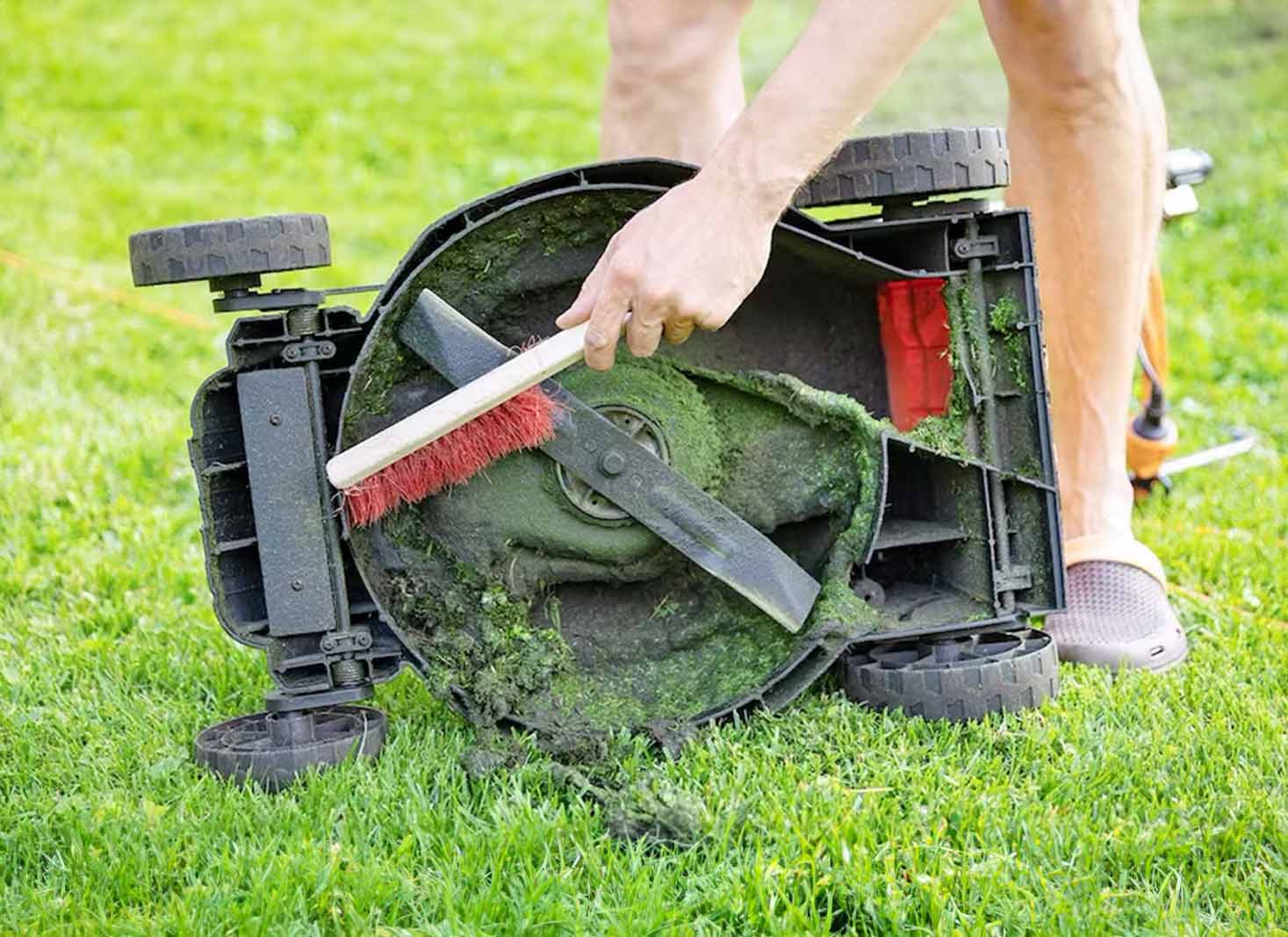Opinions vary regarding the practice of cutting damp grass. Some contend that it’s fine, provided certain precautions are observed, whereas others strongly oppose doing it under any circumstances.
Generally, mowing grass is not recommended for several reasons. Those reasons include the risk of electric shock, slipping and falling, and damage to the mower. Also, when mowing wet grass, it’s almost impossible to get an even cut, and you can easily damage the base of your lawn.
In this article, we will talk about wet grass mowing and give you some useful tips on what you should do if it is necessary to mow your lawn after rain.

What we cover
ToggleThe risks of mowing wet grass
When it comes to mowing wet grass, it’s important to understand the potential risks involved. While it may be tempting to get the job done quickly, there are several reasons why it’s best to wait for the grass to dry before mowing.
Risk of electric shock
It is very simple, water and electricity don’t go together. Serious consequences can occur especially if you use a mower with an extension cord. If you expose the connections to moisture it will lead to damage to the machine and electrocution to the operator, ie you.
Also, be careful when using gas-powered mowers too, because if rainwater gets into the fuel tank it can cause a malfunction to the engine.
Personal danger
Another risk of mowing wet grass is safety concerns. Wet grass can be slippery, increasing the risk of slipping and falling while mowing. This can be especially dangerous if mowing on slopes. Regardless of the terrain and the type of mower used, there is always some danger of slipping on slick turf.
Mowing wet grass can cause damage to your mower
Fuel in the mower’s gas tank can be contaminated because of excessive moisture and can corrode the complete machine eventually. Also, the grass clippings can interfere with the mower’s job by sticking to the equipment in clumps that block the vacuum or the blade itself and force the machine to work harder.

Very difficult to get an even cut
Because wet grass blades are slick and tough to slice, even cutting is very hard to achieve. Also, wet grass clumps together and lawn mower blades can not easily cut through thick clumps so you will end up with a raggedy mess.
Furthermore, when mowing on wet soggy grass it is more likely for grass to be pulled up out of the ground entirely rather than being cleanly cut.
Fungal disease spreading
If you conduct mowing right after the rainfall fungal diseases can likely develop in your lawn. The reason for this is a lack of airflow to dry out the cut grass. Also, the wet grass clippings that stick to the underside of the mower deck can grow mold that can be spread across your lawn the next time you mow.
Damage to lawn
One of the biggest risks of mowing wet grass is the potential for damage to the lawn. Wet grass is more easily torn and damaged, which can lead to unsightly brown patches and uneven growth. In addition, the clippings from wet grass can easily clog up the mower, causing damage if not taken care of. These clippings can also be expelled from the mower in large sections, which can smother the planted grass, causing patches of the lawn to die or dry up.
Extra clean-up
Damp grass clippings become extra sticky so mowing them requires extra clean-up afterward. If the machinery stays wet for a long time the damp grass clippings that stick to a mower’s undercarriage can become a breeding ground for mold.
Also, pay attention to the stains and remove them from your clothes, shoes, and driveway right away because the chlorophyll in freshly cut wet grass causes more stains than usual.
How to mow wet grass
If your situation requires mowing your lawn right after the rainstorm, follow these tips to avoid damaging your grass and finish the job safely.
Step 1: Test for soft ground
Don’t mow if the soil feels muddy or your shoes get soaked when walk through it. These conditions will leave your lawn looking worse than just slightly unkempt.
Step 2: Remove excess water
If the soil is not muddy and the grass is just a little moist, drag an extended hose pipe horizontally over your lawn to remove as much water as possible. This is similar to what you do on your shower door with a squeegee. Direct the water into an area of the yard where it can be absorbed.
Step 3: Prepare the mower
The preparation of the mower includes sharp blades. Ensure that blades are razor sharp because this will help to reduce the pressure on your mower and cut the grass more easily.
Also, raising the mower blade by a level or two will reduce the effort needed and result in a neat, even cut.
Step 4: Start small and slow
Start by mowing a small row and go slowly and if your mower sounds like it is struggling then stop and wait until the grass is drier or you risk overheating and breaking the machine.
Pro tips and tricks
Empty the catcher frequently – Don’t wait until the grass collector basket is full. Emptying the basket more often during mowing will contribute to an easier operation of the mower.
Also, this will prevent the mower deck, where the blades are located, from becoming clogged and will reduce the strain on the mower.
Clean the mower afterward – This you should always do, but proper cleaning is very important after mowing wet grass. Damp grass can collect on the underside of the mower and clog up air inlets and filters, so they must be removed. Always disconnect the mower from the power before cleaning.
Wet grass mowing techniques
When mowing wet grass, adjust your mowing technique to minimize damage to the lawn. Here are some tips:
- Mow slowly: Wet grass is heavier than dry grass, so you’ll need to mow more slowly than usual. This will help prevent the mower from bogging down and tearing the grass.
- Use a side-discharge mower: Wet grass can clog up a bagging mower, so use a side-discharge mower instead. This will also help prevent clumps of wet grass from smothering the lawn.
- Mow in a different pattern: If you always mow in the same direction, try mowing perpendicular to your usual pattern. This will help prevent ruts from forming in the wet soil.
- Avoid turning sharply: Wet soil is more prone to damage than dry soil, so avoid turning sharply when mowing. Instead, make gradual turns to minimize soil compaction.
Post-mowing care
After mowing wet grass, there are a few things you can do to help your lawn recover:
- Remove clumps of grass: If your mower leaves clumps of wet grass on the lawn, remove them with a rake or leaf blower. Leaving clumps of grass on the lawn can smother the grass and create a breeding ground for pests and diseases.
- Water the lawn: Wet grass can be stressful for the lawn, so give it a little extra water to help it recover.
- Fertilize the lawn: Wet grass can leach nutrients from the soil, so consider fertilizing your lawn after mowing. This will help replace any nutrients that were lost.
FAQ's
Mowing wet grass with a riding mower is not recommended. It can be dangerous as the mower can slip and slide on the wet surface, leading to accidents and injuries. Additionally, the wet grass can clog the mower’s blades, which can damage the machine.
Cutting wet grass can lead to several problems. Wet grass can be slippery, making it difficult to walk on and increasing the risk of falls and injuries. Wet grass can also clog the mower’s blades, leading to an uneven cut and damaging the machine. Furthermore, cutting wet grass can spread diseases and pests, as the wet grass clippings can stick to the mower and spread to other areas of the lawn.
It is best to wait until the grass is dry before mowing your lawn after rain. This usually takes a few hours or a day, depending on the weather conditions. Mowing wet grass can cause damage to the grass and the soil, as well as the mower.
Using a zero-turn mower on wet grass is not recommended. The mower’s wheels can slip on the wet surface, causing the machine to lose traction and potentially causing accidents. Additionally, the wet grass can clog the mower’s blades, leading to an uneven cut and damaging the machine.
Mowing wet grass can lead to several problems. Wet grass can clog the mower’s blades, leading to an uneven cut and damaging the machine. Additionally, the wet grass clippings can stick to the mower and spread diseases and pests to other areas of the lawn. Moreover, mowing wet grass can damage the grass and the soil, leading to poor growth and unhealthy lawns.
If the blades on your mower are sharpened, mowing the grass with morning dew is fine as long as the grass is not soaking wet. On the other hand, morning dew takes only a few hours so it is better to wait for your grass to be completely dry.






